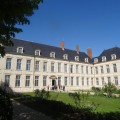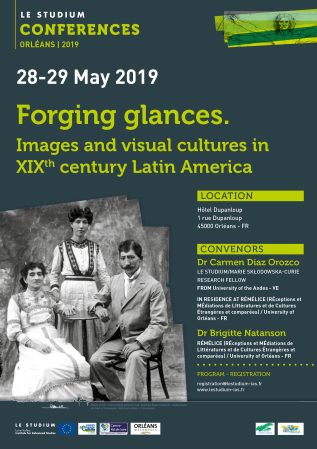Forging glances.
Images and visual cultures in XIXth century Latin America
Hôtel Dupanloup
1 rue Dupanloup
45000 Orléans
France
Presentation
In an unprecedented essay on the pose and societies of scopic filiation, Sylvia Molloy reflects on the power of the exhibition and the underlying visual culture in 19th century Latin America. “Todo apela a la vista y todo se especulariza” [1], Molloy will say and she will return to a semiotics of the image of an irreversible nature, at least concerning the representation of the real and the construction of a view of the nation, and of the subjectivities, corporalities and sensitivities that articulate in its framed, singularly tied to the emerging Latin American republics of the 19th century. This colloquium proposes to reflect that transition moment during which the old literate city (Rama, 1984) seems to deal with visual culture in order to create new contents. Forging glances will be the key to this moment, as demonstrated not only by the photography of subjects and cities, but also by the universal exhibitions that, serving the nascent republics of the continent, served as showcases for national progress and stimulated the urgent foreign investment in countries as Chile (1875), Argentina (1882) and Venezuela (1883), among others. In this eagerness, literary panoramas, costumbrian watercolors, galleries of illustrious men, the albums of young ladies, panoramas, slide shows and photographs stood out and behaved as new visibility devices. It is a question of reviewing how the letter and the image coexisted in order to make visible the cultural contents of their time. How they negotiated their permanence in the cultural field of that time, how these new visibility devices interrogated female identity, how far they permeated the literary and editorial content of their time, how the nation was illustrated through new forms of writing such as chronicles and fashion magazines, serial prints and advertisement, newspapers and illustrated magazines, among others. Finally, how that new grammar of the glance was configured without which contemporary audiovisual contents would be unthinkable.
French version
Dans un essai sans précédent sur la pose et les sociétés de filiation scopique, Sylvia Molloy s’interroge sur le pouvoir de l'exhibition et de la culture visuelle qui la soutient dans l’Amérique latine du XIXe siècle. “Todo apela a la vista y todo se especulariza” [1], dira Molloy et, avec Martí, elle reviendra sur une sémiotique de l'image de caractère irréversible, du moins en ce qui concerne la représentation du réel et la construction d'un regard sur la nation, et sur les subjectivités, corporalités et sensibilités qui s'y articulent, singulièrement liées aux républiques latino-américaines émergentes du XIXe siècle.
Ce colloque propose de se pencher sur ce moment de transition pendant lequel l’ancienne ville lettrée (Rama, 1984) semble négocier avec la culture visuelle dans la création de nouveaux contenus. Forger les regards sera la clé de l’époque, comme en témoignent non seulement les photographies de sujets et de villes, mais aussi les expositions universelles qui, mises au service des naissantes républiques du continent, ont servi de vitrines du progrès national et ont aiguillonné les investissements étrangers toujours plus pressants dans des pays comme le Chili (1875), l'Argentine (1882) et le Venezuela (1883), parmi d'autres. Dans cette ferveur se distinguent, également, les panoramas littéraires, les aquarelles et tableaux de mœurs, les galeries d'hommes illustres, les albums de demoiselles, les panoramas, les diaporamas et les photographies qui, pour leur part, se sont comportés comme de novateurs dispositifs de visibilité.
Il s'agit d’observer comment la lettre et l'image coexistaient pour rendre visibles les contenus culturels de leur époque. Comment elles ont négocié leur permanence dans le domaine culturel de leur temps, comment ces nouveaux dispositifs de visibilité ont défié le féminin, dans quelle mesure ils ont imprégné les contenus littéraires et éditoriaux de leur époque, comment la nation a été illustrée par de nouvelles formes d'écriture telles que les chroniques et magazines de mode, le feuilleton et la publicité, les journaux des annonces et les magazines illustrés, etc. ; et, enfin, comment s’est configurée cette nouvelle grammaire du regard sans laquelle le contenu audiovisuel contemporain aurait été inconcevable.
[1] Molloy, Sylvia, 2012. “Políticas de la Pose”. En Poses de fin de siglo. Desbordes del género en la modernidad. Buenos Aires, Eterna Cadencia. Pgs 128 - 137.
Convenors
- Dr Carmen Díaz Orozco, LE STUDIUM / Marie Skłodowska-Curie Research Fellow
FROM: University of the Andes - VE
IN RESIDENCE AT: RÉMÉLICE (RÉceptions et MÉdiations de LIttératures et de Cultures Étrangères et comparées) / University of Orléans - FR - Dr Brigitte Natanson,
RÉMÉLICE (RÉceptions et MÉdiations de LIttératures et de Cultures Étrangères et comparées) / University of Orléans - FR
Slideshow

Participants
- Dr Nancy Calomarde, National University of Cordoba - AR
- Dr Mónica Cárdenas, University of La Réunion - FR
- Dr Isabel Clúa, University of Sevilla - ES
- Dr Eleonora Cróquer, University Simón Bolívar - VE
- Dr Dorde Cuvardic-Garcia, University of Costa Rica - CR
- Dr Sebastian Diaz-Duhalde, Dartmouth College - US
- Dr Luis Duno-Gottberg, Rice University - US
- Prof. Nathalie Fürstenberger, Paul Valéry University of Montpellier - FR
- Dr Beatriz González-Stephan, Rice University - US
- Dr Susan Hallstead, University of Colorado Boulder - US
- Prof. Javier Guerrero, Princeton University - US
- Dr Nuria Girona Fibla, University of Valencia - ES
- Danislady Mazorra Ruiz, University Versailles of Saint-Quentin-en-Yvelines - FR
Location
Hôtel Dupanloup : 1, rue Dupanloup - 45000 ORLEANS - FR
The conference venue is unique. Located right next to the Orléans’ cathedral, the episcopal palace of Orléans, built between 1635 and 1641, locally known as the Hôtel Dupanloup, is a classical French building which served until 1905 of residence to the bishops of Orléans. Since 2014, the renewed palace hosts the International University Center for Research and Le Studium Loire Valley Institute for Advanced Studies.
Participants will be welcomed in this exceptional surrounding, blending Middle Age and Renaissance cultures with modern design and will have the opportunity to discover French cuisine and wines.
PRACTICAL INFORMATION
Conference programme
Tuesday May 28th 2019
- 09:00 Welcome coffee & registration
- 09:45 Official Opening by Dr Karin Fischer (Director of RÉMÉLICE, University of Orléans) & Sophie Gabillet (General Secretary of LE STUDIUM)
- 10:15 Introduction by Dr Carmen Díaz Orozco (General coordinator of the event)
- 10:30 Inaugural Conference: Dr Eleonora Cróquer - The fin-du-siècle nymph: excessive and exceeded, an image of the modern author as pathosformel of the Latin American end of the nineteenth century
Session 1: Glances, women and private space (Moderator : Dr Luis Duno-Gottberg)
- 11:30 Dr Isabel Clúa - "La casa maravillosa de Tórtola Valencia”: exhibition, intimacy and authorial pose
- 12:15 Lunch
- 13:30 Dr Nancy Calomarde - Postcards of the deterritorialization in the writing of Gertrudis de Avellaneda
- 14:15 Dr Beatriz González-Stephan - Photonovela and pre-cinematic fiction: Una Holandesa en América (c.1880-86) by Soledad Acosta de Samper
- 15:00 Coffee break
Session 2: Glances, sensitivities and visualizations (Moderator : Dr Nuria Girona)
- 15:30 Dr Carmen Díaz Orozco - Making bodies. Popular type and hygiene in El Cojo Ilustrado of Caracas.
- 16:30 Guided visit of the Sainte-Croix Cathedral in Orléans
- 18:30 Public Lecture in French : Dr Mónica Cárdenas Moreno - La construction de la femme moderne dans la presse illustrée parisienne du XIXe siècle
- 20:00 Gala dinner - Le Lift
Wednesday May 29th 2019
- 09:00 Welcome coffee
Session 3: Glances, objects and places (Moderator : Dr Nancy Calomarde)
- 09:30 Dr Luis Duno-Gottberg - Colonial Structures and "End of the World" on the Island of Martinique. Notes on the Visual Representation of the Eruption of Mount Pelée.
- 09:45 Dr Susan Hallstead - El Correo del Domingo (1864 - 1868), consumerist excesses, identity and modernization in post-Rossian Argentina
- 10:30 Coffee break
- 11:00 Dr Dorde Cuvardic-García - The 'esquina de avisos' in 19th century Latin American visual culture and literature
- 11:45 Dr Sebastián Díaz-Duhalde - Firebirds. Notes for a visual anthropology of national airspace during the 19th century
- 12:30 Lunch
Session 4: Glances, desires and shows (Moderator : Dr Carmen Díaz Orozco)
- 14:00 Danislady Mazorra Ruiz - Bodies in action: the allegorical image of Cuba in the war of '98.
- 14:45 Prof. Nathalie Fürstenberger - ‘Peinetones’ and public (dis)order
- 15:30 Coffee break
- 16:00 Prof. Javier Guerrero - Blind date: Oscar Wilde in New York
- 16:45 Dr Nuria Girona Fibla - Salomé and the artist's performance at the end of the century
- 17:30 Rapporteurship by Dr Eleonora Cróquer








